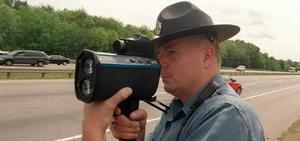Law-enforcement technologyPolice radar can identify suicide bombers
The radar guns police use to spot speeding motorists fire microwave pulses at a car and measures the Doppler shift of the reflected signal to calculate its velocity; researchers found that the strength and polarization of the reflected signal — the “radar cross section” — can also measure the reflected signal created by the most common arrangements of looped wiring typically used by suicide bombers

A new tool in counter-terror work // Source: boston.com
The radar guns police use to spot speeding motorists have inspired a version that aims to identify a would-be suicide bomber in a crowd. A radar gun fires microwave pulses at a car and measures the Doppler shift of the reflected signal to calculate its velocity. Researchers say that the strength and polarization of the reflected signal — the “radar cross section” — can provide additional information about the size and shape of the reflecting object and the material it is made from.
Paul Marks writes that William Fox of the Naval Postgraduate School in Monterey, California, and John Vesecky of the University of California, Santa Cruz, wondered whether the wiring in a suicide vest would alter the radar cross section of a bomber enough to allow a radar gun to pick him or her out in a crowd.
To find out, the pair used software to simulate how radar signals at 1 gigahertz and 10 gigahertz would be reflected by the most common arrangements of looped wiring typically used by suicide bombers. They found that the clearest reflected signals were in the 10 gigahertz range.
Together with colleague Kenneth Laws, they then fired low-power 10 gigahertz radar pulses at groups of volunteers, some wearing vests wired up like suicide vests. About 85 percent of the time, telltale factors in the polarization of the reflected signals allowed them correctly to identify a “bomber” up to ten meters away.
The team hopes the U.S. Army will fund further development of the system, allowing them to boost the detection rate and include refinements to avoid false alarms being triggered by metal in underwired bras, jewellery, and earphone leads.
The inventors suggest military checkpoints would be major users of such a system — but it could also be installed alongside CCTV cameras in shopping malls, railway stations, airports, and high streets.
Overcoming false alarms will be a major challenge, says radar engineer Sam Pumphrey of the U.K.-based research and development company Cambridge Consultants, which is developing a radar system to detect explosives that may have been concealed within the walls of buildings as they were constructed. He thinks a bomb detection system that relies on radar guns alone might well be prone to false positives.
Fox agrees. He says that radar can be used in combination with other technologies, including smart surveillance cameras that can identify suspicious behavior , and infrared imaging, which exploits the fact that explosives belts are often cooler than the body. Such a system could help security staff spot bombers from afar and discreetly begin an evacuation.
—Read more in William P. Fox, “Sensing and identifying the improvised explosive device suicide bombers: people carrying wires on their body,” Journal of Defense Modeling and Simulation (11 October 2010) (doi: 10.1177/1548512910384604)
